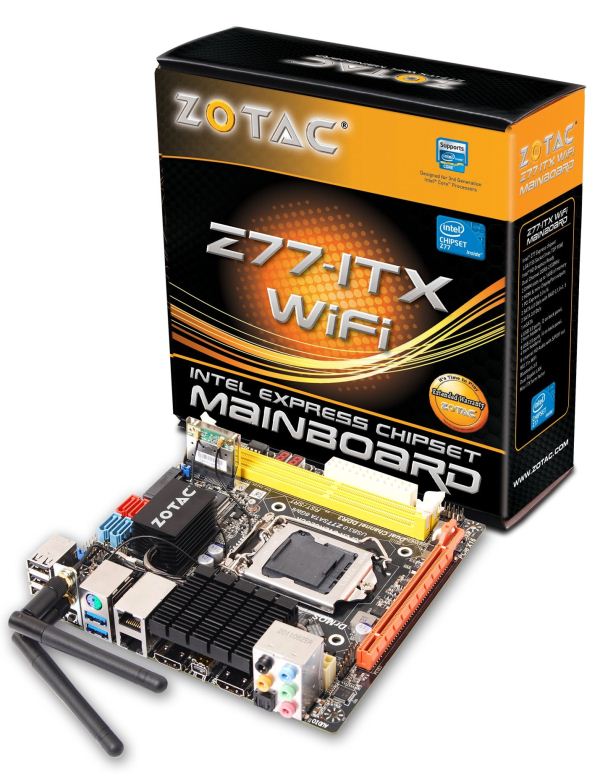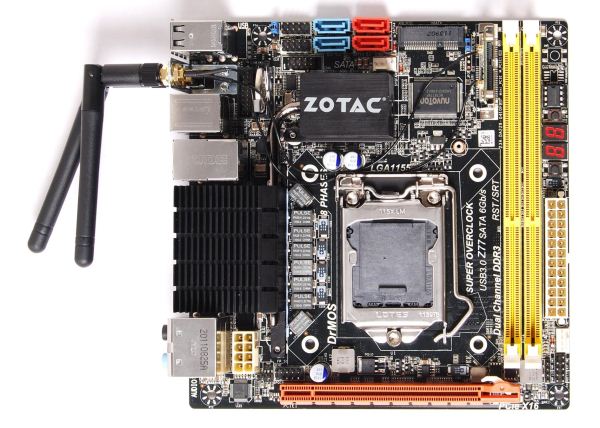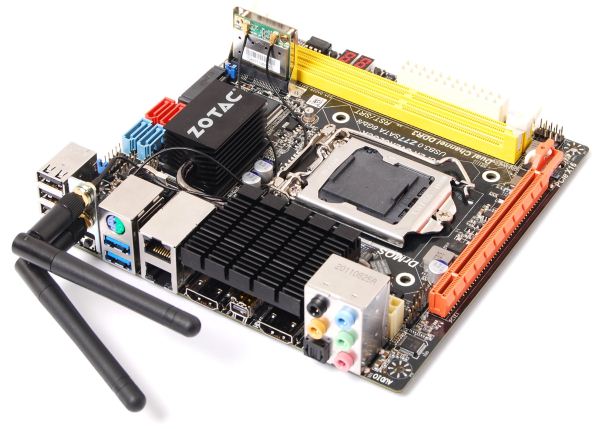Z77 mITX Round-Up: Five of the Best – MSI, Zotac, ASRock, EVGA and ASUS
by Ian Cutress on December 31, 2012 7:00 AM EST- Posted in
- Motherboards
- MSI
- ASRock
- EVGA
- ZOTAC
- Asus
- Ivy Bridge
- Z77
- mITX
Zotac
If you ever wanted small form factor, then Zotac has always been an option, sprouting mITX products for every platform and chipset. With Ivy Bridge and 7-series platforms, Zotac has announced three products so far – two H77 motherboards (-A-E and -B-E), and this motherboard, the Z77-ITX WiFi (also known as the Z77-A-E).
Historically Zotac has not had the ability to innovate as much as the key players in the motherboard industry. Part of this is down to the 'real estate on the PCB of a mITX' factor – the chipset specification deals with a significant amount of the actual hardware on board, but part of it is also due to the size of the company in correlation to their R&D. In this context Zotac fit in the same niche as Biostar – whatever we do see in terms of innovation is few and far between. However every now and again we are pleasantly surprised, as long as it fits into the correct price bracket.
With that, let us start with the Z77-ITX WiFi.
Zotac Z77-ITX WIFI Overview
When testing the Zotac Z77-ITX, I initially ran through the benchmark suite with a high end i7-3770K, and again recently with an i3-3225. In terms of performance, there were several key factors worth noting, such as the slightly slower times in our WinRAR testing compared to other Z77 products. This test relies on the motherboard to apply turbo multipliers given varied load – it is a test that top tier manufacturers seem to do well in, but the lesser manufacturers fall behind. On the plus side, we get a fast POST time (9.18 seconds with a discrete GPU installed), low power usage (20W long idle on a 500W Platinum PSU with a discrete GPU installed, 32W idle) and a sub-200 microsecond DPC Latency test.
Hardware wise, Zotac take a different tack to the video outputs compared to the rest of the Z77 crowd. The Z77 platform with an Ivy Bridge processor allows for 3 digital display outputs and one analogue; most motherboard vendors take this to mean ‘we want one of each output’. Zotac, like Gigabyte, decided to make two of these outputs HDMI to cater for the majority of dual screen home setups (or to supply audio out of one and video out of the other). Rather than give a combination DVI-I port, Zotac also equipped the board with a mDP port and placed in the package a mDP to DP adaptor. If you want a modern digital connection from a Z77 mITX board, Zotac has you covered.
Also relating to hardware, Zotac have given this board a dual NIC as well as WiFi on board, giving network connectivity a high priority. On the downside, we only get a Realtek ALC889, which also failed our RMAA 192 kHz test. The USB 2.0 copy times were quite low, but improved while the CPU was under load, suggesting that some of the BIOS default options are not optimal for USB transfer. The big BIOS option faux pas however is the reluctance for Zotac to move into 2012 and enable AHCI on their SATA ports by default. Also, if you were looking for software for OC or fan control software, unfortunately you will not find them on a Zotac board.
The Zotac Z77-ITX is currently fluctuating wildly in price. When I started the testing for this review, it was at $130. I now see it on Newegg for $163. For the former, it warrants a consideration when weighing up the pros and cons between which Z77 mITX motherboard to choose – having all those extras in the box helps sweeten the deal if you can overlook some of the possible issues.
Visual Inspection
As one of the first Z77 ITX motherboard on the test bed, it is hard not to notice the arrangement of the motherboard as a whole. The location of the socket is very close to the PCIe connector – with the limitations of the mITX platform, the Intel minimum specified distance of components away from the socket (marked by the white box around the socket) is adhered to but only just. This comes into play when we deal with different air coolers on such a platform.
Typically with a Z77 motherboard we see the chipset and additional IO chips to the south of the memory slots, but there is no such luxury on the Zotac Z77-ITX WiFi – we have the chipset located above the CPU, along with our SATA connectivity. In terms of SATA ports, Zotac uses the two SATA 6 Gbps and two SATA 3 Gbps from the chipset for direct SATA connections – another of the SATA 3 Gbps from the chipset is used for the mSATA port to the right of the SATA ports. This should leave one more for an eSATA port on the back IO, but we find no eSATA port.
Fan headers on board are oddly positioned – with a mITX platform I would expect at least two, if not three, and we get two 4-pin headers here. We find a CPU header on the right hand side below the 24-pin ATX power connector and a 4-pin SYS header between the chipset heatsink and the SATA ports. A lot of the space on the right hand side is taken up by the full length DDR3 memory slots – in the past we have seen Zotac switch them out for SO-DIMM memory ports, which could always be an idea for this platform (or if possible, angled SO-DIMM on the back of the board (?)).
The heatsink arrangement for the Zotac covers the chipset above the socket, and the VRM. Zotac have decided to extend the heatsink over the IO panel due to their back panel port arrangement. Even with the fan headers, this should help with cooling if the system were to be pushed with a high wattage chip and an overclock.
The location of the 8-pin CPU power connector is a little odd – we find it on the bottom of the board below the heatsink for the power delivery. This means that any power supply would need to reach over parts of the board in order to connect in. Zotac get around this by including an 8-pin CPU power extension cable in the box, but that still leaves the fact that a cable is somewhere potentially blocking airflow.
Other features directly visible on the board are the mSATA port and the WiFi module, both located above the CPU socket and to the right. The WiFi card is perpendicular to the board itself, and runs two small cables to antenna ports on the back panel – I personally found these cables a little annoying when trying to plug peripherals in to the ports when the board was fixed in a case.
The mSATA port is something that will crop up on mITX boards from now on, providing the possibility of running a smaller form factor if you want to pick up an mSATA SSD. As mSATA densities get higher, this will become more viable for Windows users (where Windows 7 x64 Ultimate requires a drive more than 32GB).
Also on board are various headers for the front panel, the front panel audio, two USB 2.0 headers, a USB 3.0 header (found near the IO), a two-digit debug LED and power and reset buttons. The location of the USB 3.0 header is strange, as in a mITX platform it would more likely be for a front case connector or a separate USB 3.0 panel. It is nice to see a debug LED on board however – I did have to use it a couple of times to determine why the board was failing to boot.
On the back panel, the IO is slightly odd compared to other Z77 motherboards we have encountered. First up is a block of four USB 2.0 ports (I like blocks like this as it gets a lot of USB connectivity sorted), a pair of antenna slots, a ClearCMOS button, a PS/2 combination port, two USB 3.0, dual Realtek NIC, dual HDMI, mini-DP, optical S/PDIF output and audio jacks. The dual HDMI is an interesting addition, as it involves in internal conversion from the DVI port to a HDMI. I wonder if there is scope for this on more mainstream Z77 motherboards, whereby video output is organized in a single IO stack of HDMI, mDP/DP, HDMI. Given our past reviews, the Gigabyte H77-ITX certainly has an inkling with their dual HDMI setup.
Board Features
| Zotac Z77-ITX | |
| Price | Link |
| Size | Mini ITX |
| CPU Interface | LGA-1155 |
| Chipset | Intel Z77 |
| Memory Slots |
Two DDR3 DIMM slots supporting up to 16 GB Up to Dual Channel, 1066-2133 MHz |
| Video Outputs |
2 x HDMI mDP |
| Onboard LAN |
2 x Realtek 8111E 1 x WiFi Module |
| Onboard Audio | Reaktek ALC889 |
| Expansion Slots |
1 x PCIe 3.0 x16 1 x mSATA 1 x mini-PCIe (occupied by WiFi module) |
| Onboard SATA/RAID |
2 x SATA 6 Gbps, Supporting RAID 0, 1, 5, 10 2 x SATA 3 Gbps, Supporting RAID 0, 1, 5, 10 1 x mSATA / mini-PCIe |
| USB |
4 x USB 3.0 (Chipset) [2 back panel, 2 onboard] 8 x USB 2.0 (Chipset) [4 back panel, 4 onboard] |
| Onboard |
2 x SATA 6 Gbps 2 x SATA 3 Gbps 1 x USB 3.0 Header 2 x USB 2.0 Headers 2 x Fan Headers 1 x mSATA / mini-PCIe 1 x Front Panel Audio Power/Reset Buttons Two-Digit LED Debug |
| Power Connectors |
1 x 24-pin ATX Power Connector 1 x 8-pin CPU Power Connector |
| Fan Headers |
1 x PWR (4-pin) 1 x SYS (4-pin) |
| IO Panel |
4 x USB 2.0 2 x Antenna 1 x Clear CMOS 1 x PS/2 Combination Port 2 x USB 3.0 2 x Realtek 8111E GbE 2 x HDMI 1 x mDP 1 x Optical SPDIF Output Audio Jacks |
| Warranty Period | 3 Years |
| Product Page | Link |
On the pure hardware side, apart from the arrangement of the socket area, we could call Zotac out on one or two design issues. The lack of an analogue output, even in the modern era, could be an oversight – this all comes down to the design of the package. We also only have the Realtek ALC889 audio codec, rather than the ALC89x series, and for some reason it fails the RMAA 192 kHz test. It is worthy of note however to mention the dual NIC + WiFi which is rare on a mITX board, as well as the presence of power/reset buttons in conjunction with a two-digit debug LED, useful for troubleshooting.














54 Comments
View All Comments
Sabresiberian - Tuesday, January 1, 2013 - link
Thanks for the great comparison review!It looks like there is a little mistake in the spec list for the Asus board, which shows it having a mini-PCIe connector. I would love it if it did, but I didn't see it on the board and it isn't mentioned in other spec lists.
It is important to me because I would ideally need connection for both a graphics card and a sound card (which I believe I could do through a mini-PCIe to PCIe x1 adapter if needed). This makes the EVGA Stinger the choice for me here, though the Asus board is the one I would prefer to buy.
I am truthfully a little disappointed in the EVGA board, which seems all too common with EVGA products in general these days. Great support is still there, but I'd rather they build bleeding edge components and not have to find out whether or not their support is as good as people say it is. The Stinger is a good board to be sure, and the Intel LAN alone puts it in the category of "will buy" for me, but I was hoping it would be something that would match or beat the Asus P877-I, and it just doesn't.
Foeketijn - Tuesday, January 1, 2013 - link
When you take overclocking out of the equation, B75 has it all, for the price just a tiny bit north of the old H61 chipset. Support for IB features (1600Mhz DDR3, PCI-e 3.0), Native Sata III, USB 3.0.It wasn't intended for the DIY market but fits the bill perfectly in my opinion. Only the very very few who need to OC, +16Gb ram or multiple SSD's @ full 6 Gb/s need the Z77 chipset.
The only thing is, that us mere mortals can't predict is, if a much cheaper chipset is used, did the OEM also cheapskate on the critical parts to? I would love to see some in-depth component analysis which I see for example, when a PSU is taken apart.
Which components are used? how well is the soldering done, does it still work at a sauna lanparty, etc.
I might be alone in this, but I would find that much more valuable information than all the performance benchmarks together (race to the bottom, be dammed!).
Including the northbridge in the CPU made motherboard and CPU reviews so predictible (or borring).Since then, I'm only interested in stability, ease of installation (nicely covered) and practical use (fan controll, MEM compatibility ect).
<offtopic> Oh I loved the XP-m 2500+ siverpainting 2001 era where you actually could get a noticeable improvement of performance and not necessarily have to sacrifice stability or risk bankruptcy</offtopic>
vanwazltoff - Tuesday, January 1, 2013 - link
i picked up an asus p8z77-i deluxe/wd before christmas and made a beast gaming computer out of it with an i5-3750k OCed to 4.5ghz and a gtx670 =]vanwazltoff - Tuesday, January 1, 2013 - link
*3570kBeaver M. - Tuesday, January 1, 2013 - link
Loved the POST screen measurements and the DPC latency testing. Something you dont see every day. Actually Ive never seen it, and yet I always wanted to know those.However I am not really interested in the Z77s, since they have a horrible layout for my needs. Only the Asus one comes close to what I need, but I just dont buy Asus anymore because of several very bas experiences.
So, I wish you would also test the B75 and H77s.
paksoy - Tuesday, January 1, 2013 - link
I love the features of this Asus mobo, but i want to use it in a really small form factor case like the Antec ISK 110 VESA Case.http://www.anandtech.com/show/6192/antec-isk-110-v...
I'm just worried that the height of the VRAM board would prevent it from using it with this case.
mi1stormilst - Tuesday, January 1, 2013 - link
I still opted for the Gigabyte Z77N and love it...Sivar - Wednesday, January 2, 2013 - link
Does this refer to the ALC889 playing an audio file encoded at 192KHz?If so, does it really matter? Failing a test is never a good thing, but I know of no widely available 192KHz audio source, and such a source would have no benefit, nor would a 96KHz source.
cjs150 - Wednesday, January 2, 2013 - link
I am a happy user of the AS Rock board in a silent HTPC. It works exceptionally well. However it is clear that some work still needs to be done on motherboard design.MSata on back is excellent - now can we have it as SATA 3 because the better MSata SSDs are all Sata 3.
Placement of Sata connectors is often awkward on these boards. On edge and at right angles please.
Similarly I would love it if someone either did the 24 pin ATX power connector at right angles or someone manufactured a right angled converter that did not require de soldering the motherboard connector. Cable management in Mini-OTX is very hard and that would really help.
Finally, careful choice of RAM can eliminate issues Ian had about the closeness of the CPU socket preventing the use of many after market coolers. I use the Samsung green low profie memory, which is so low that any after market cooler can be used (and runs at 1.35v, is an unbelievably good overclocker and reasonably priced!)
romrunning - Wednesday, January 2, 2013 - link
As has been mentioned previously, the H77 chipset is great for those who do not need overclocking. I've used the Intel DH77DF, and I heartily recommend it. Since the DH77DF has an eSATA port (not too common), I've even been able to keep an eSATA dock that I used before USB 3.0 was more readily available. If you install this board into a Fractal Design Node 304 case, you can use all of the SATA ports as well. I've used it with a Silverstone SG05 case, and the loudest part of my setup is the fan on the graphics card (Radeon 7850).One thing I've noticed, though, is the relatively low mic input from the front audio. Not sure if this is common to the Realtek ALC8xx chip series, but even after boosting the gain in Win7 to +30db, it still isn't quite as loud as an older AMD board I previously had (which didn't need a boost at all).